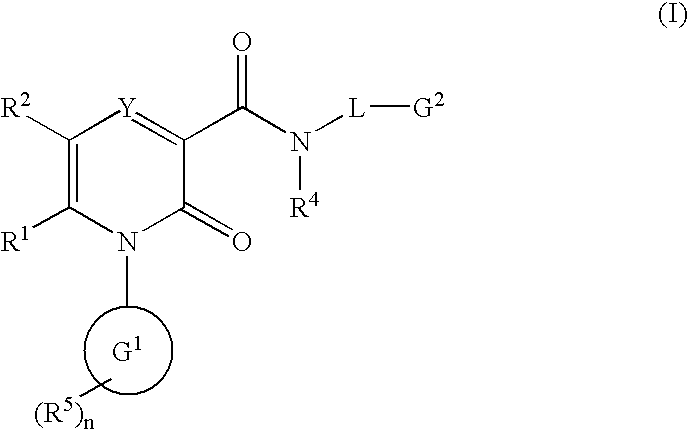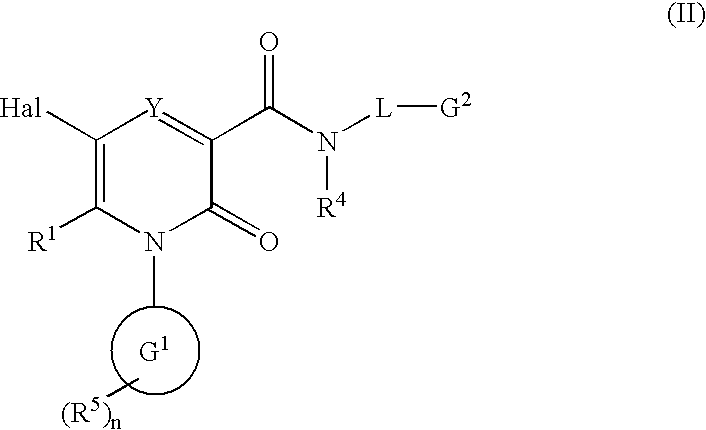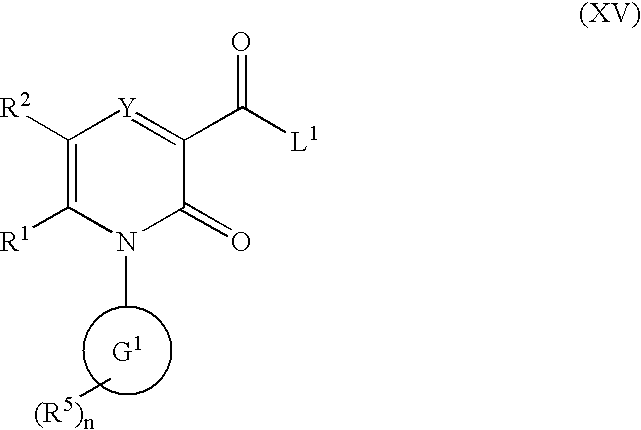2-Pyridone derivatives as neutrophil elastase inhibitors and their use
a technology of neutrophil elastase and derivatives, which is applied in the direction of biocide, heterocyclic compound active ingredients, drug compositions, etc., can solve the problems of affecting the function of neutrophil elastase, and degrading virtually all connective tissue components, so as to reduce the risk, reduce the effect of organ rejection, and enhance collagen remodelling
- Summary
- Abstract
- Description
- Claims
- Application Information
AI Technical Summary
Benefits of technology
Problems solved by technology
Method used
Image
Examples
example 2
6-Methyl-N-[4-(methylsulfonyl)benzyl]-5-nitro-2-oxo-1-[3-(trifluoromethyl)phenyl]-1,2-dihydropyridine-3-carboxamide
[0306] To a solution of 6-methyl-N-[4-(methylsulfonyl)benzyl]-2-oxo-1-[3-(trifluoromethyl)phenyl]-1,2-dihydropyridine-3-carboxamide (52 mg, 0.11 mmol) in acetic anhydride (2 ml) was added fuming nitric acid (0.1 ml, 2.1 mmol). The reaction mixture was stirred at room temperature for 40 min. The mixture was partitioned between ethyl acetate and aqueous sodium hydrogen carbonate. The organic layer was washed with water, dried over sodium sulfate, filtered and concentrated in vacuo. The residue was purified by preparative HPLC to give the title compound as a yellow powder (13 mg, 23%).
[0307]1H NMR (CDCl3): δ 9.47 (1H, t, J 5.6 Hz); 9.31 (1H, s); 7.92-7.86 (3H, m); 7.81 (1H, t, J 7.9 Hz); 7.54-7.48 (3H, m); 7.44 (1H, d, J 7.9 Hz); 4.69 (2H, dd, J 5.9, 3.9 Hz); 3.03 (3H, s); 2.52 (3H, s).
[0308] APCI-MS m / z: 510 [MH+].
example 3
5-(1-Butoxyvinyl)-6-methyl-N-[4-(methylsulfonyl)benzyl]-2-oxo-1-[3-(trifluoromethyl)phenyl]-1,2-dihydropyridine-3-carboxamide
[0309] In a Schlenk vessel equipped with a magnetic stirring bar were placed 5-iodo-6-methyl-N-[4-(methylsulfonyl)benzyl]-2-oxo-1-[3-(trifluoromethyl)phenyl]-1,2-dihydropyridine-3-carboxamide (101.5 mg, 0.17 mmol), bis[1.2-bis(diphenylphosphino)ethane]-palladium (0) (16.5 mg, 18.3 μmol), n-butyl vinyl ether (60 μl, 0.46 mmol), triethylamine (0.5 ml, 3.6 mmol) and DMF (6 ml). The vessel was purged with argon, sealed and heated at 100° C. overnight. The reaction mixture was cooled and partitioned between ethyl acetate and water. The organic layer was dried over sodium sulphate, filtered and concentrated in vacuo. The residue was purified by preparative HPLC to give the title compound as a white solid (27.3 mg, 28%).
[0310]1H NMR (CDCl3): δ 9.96 (1H, t, J 5.8 Hz); 8.64 (1H, s); 7.89 (2H, d, J 8.3 Hz); 7.82 (1H, d, J 8.0 Hz); 7.75 (1H, t, J 7.9 Hz); 7.56-7.50 (3H...
example 4
5-Acetyl-6-methyl-N-[4-(methylsulfonyl)benzyl]-2-oxo-1-[3-(trifluoromethyl)phenyl]-1,2-dihydropyridine-3-carboxamide
[0312] To a solution of 5-(1-butoxyvinyl)-6-methyl-N-[4-(methylsulfonyl)benzyl]-2-oxo-1-[3-(trifluoromethyl)phenyl]-1,2-dihydropyridine-3-carboxamide (38 mg, 67.5 μmol) in DMF (0.5 ml) was added aqueous hydrochloric acid (2.0M, 50 μl). After 20 min. the solution was neutralized with aqueous sodium hydrogen carbonate. The reaction mixture was purified by preparative HPLC to give the title compound as a white solid (17.6 mg, 51%).
[0313]1H NMR (CDCl3): δ 9.75 (1H, t, J 5.7 Hz); 9.08 (1H, s); 7.90 (2H, d, J 8.3 Hz); 7.85 (1H, d, J 7.9 Hz); 7.78 (1H, t, J 7.9 Hz); 7.54 (2H, d, J 8.3 Hz); 7.50 (1H, s); 7.42 (1H, d, J 8.0 Hz); 4.70 (2H, t, J 6.0 Hz); 3.03 (3H, s); 2.66 (3H, s); 2.43 (3H, s).
[0314] APCI-MS m / z: 507 [MH+].
PUM
 Login to View More
Login to View More Abstract
Description
Claims
Application Information
 Login to View More
Login to View More - R&D
- Intellectual Property
- Life Sciences
- Materials
- Tech Scout
- Unparalleled Data Quality
- Higher Quality Content
- 60% Fewer Hallucinations
Browse by: Latest US Patents, China's latest patents, Technical Efficacy Thesaurus, Application Domain, Technology Topic, Popular Technical Reports.
© 2025 PatSnap. All rights reserved.Legal|Privacy policy|Modern Slavery Act Transparency Statement|Sitemap|About US| Contact US: help@patsnap.com



